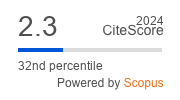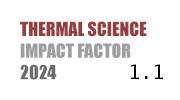THERMAL SCIENCE
International Scientific Journal
Thermal Science - Online First
online first only
Application of deep learning for acoustic impedance analysis and performance prediction in a free-piston stirling engine
ABSTRACT
A coupled thermodynamic-dynamic model of a γ-type free-piston Stirling engine is developed using Sage software to analyze impedance characteristics and predict output performance by applying two neural network algorithms. The model accounts for four key thermodynamic and dynamic parameters. These parameters determine acoustic impedance, output power, and efficiency. The results show that as a charge pressure is 2.0MPa, increasing the porosity from 0.86 to 0.93 leads to output power and efficiency increased from 22.17W to 35.12 W and the efficiency increased from 18.44% to 23.26%. At a charge pressure of 2.5MPa, as the spring stiffness of the piston rises from 1.0×104N/m to 1.7×104N/m, the real part of the acoustic impedance increases from 3.374×107Pa•s/m to 3.384×107Pa•s/m and the virtual part of the acoustic impedance decreases from 1.343×107Pa•s/m to 1.320×107Pa•s/m. Furthermore, the study employs a CNN algorithm to predict efficiency and output power, comparing its performance with that of an ANN algorithm. The CNN model demonstrates exceptional predictive accuracy, achieving an R2 value above 0.99 and a mean squared error below 2. This study demonstrates the effectiveness of integrating deep learning with simulation-based modeling to enable rapid and accurate performance prediction, offering a scalable approach for the design optimization of FPSE systems in energy applications.
KEYWORDS
PAPER SUBMITTED: 2025-03-29
PAPER REVISED: 2025-05-06
PAPER ACCEPTED: 2025-05-13
PUBLISHED ONLINE: 2025-07-05
- Chen, Y., et al., A thermally coupled cascade free piston Stirling engine based cogeneration system, Applied Thermal Engineering , 236 (2024), 121679
- Beale, W. T., Free piston Stirling engines-some model tests and simulations, SAGE Technical Paper Paper, 1969
- Chen, P. F., et al., Parametric investigation of the phase characteristics of a beta-type free piston Stirling engine based on a thermodynamic-dynamic coupled model, EnergyEnergy, 20 (2022), 119658 [4] Zare, S., et al., Design and optimization of Stirling engines using soft computing methods: a review, Applied EnergyEnergy, 283 (2021), 116258
- Li, H. Q., et al., Development of a performance analysis model for free-piston stirling power convertor in space nuclear reactor power systems, Energies, 15(3) (2022), 915 [6] Zare, S., et al., Analytical investigation of free piston Stirling engines using practical stability method, Chaos Solitons Fractals Fractals, 167 (2023), 113082
- Tavakolpour, A. R., et al., An averaging-based Lyapunov technique to design thermal oscillators: A case study on free piston Stirling engine, Energy, 189 (2019), 116127
- Wu, Z. Y., et al., A new one-dimensional model of free-piston Stirling engine based on quasi-steady flow approximation and simi-implicit numerical method, Applied Thermal Engineering, 248 (2024), 123251
- Ahmadi, M. H., et al., Passivity based-control technique incorporating genetic algorithm for design of a free piston Stirling engine, Neural Computing and Applications, 22 (2013), 1141-1150
- Tavakolpour, A. R., et al., Multi-objective optimization of Stirling heat engine using gray wolf optimization algorithm, International Journal of Engineering Transactions C: Aspects Aspects, 30.6 (2017), 321-329
- Chen, Z. W., et al., Load prediction of integrated energy systems for energy saving and carbon emission based on novel multi-scale fusion convolutional neural network, EnergyEnergy, 290 (2024), 130181
- Huang, S. Y., et al., Image classification and adversarial robustness analysis based on hybrid quantum-classical convolutional neural network, Optics Communications Communications, 533 (2023), 129287
- Kattenborn, T., et al., Review on Convolutional Neural Networks (CNN) in vegetation remote sensing, ISPRS journal of photogrammetry and remote sensingsensing, 173 (2021), pp. 24-49 [14] Gedeon, David., Sage-Object-oriented software for Stirling machine design, In Intersociety Energy Conversion Engineering Conference Conference, (1994), 4106 [15] Wang, B., et al., A high efficiency stirling-type pulse tube refrigerator for cooling above 200K, EnergyEnergy, 215 (2021), 119120
- Xu, J., et al., A thermoacoustic combined cooling, heating, and power (CCHP) system for waste heat and LNG cold energy recovery, EnergyEnergy, 227 (2021), 120341
- Luo, X. K., et al., Performance prediction and parametric optimization of γ-type free piston Stirling engine, Thermal Science, 28.1 (2024), pp. 269-281
- Gedeon, D., Sage user's guide, Gedeon Associates, 2014
- Dai, W., et al. Impedance match for Stirling type cryocoolers, Cryogenics, 51.4 (2011), pp. 168-172
- Wang, R. Y., et al., Study on the temperature adaptability of free-piston Stirling heat pump, Energy Conversion and Management, 249 (2021), 114864
- Huang, S. Y., et al., Image classification and adversarial robustness analysis based on hybrid quantum-classical convolutional neural network, Optics Communications, 533 (2023), 129287
- Ye, W. L., et al., Application of artificial neural network for predicting the dynamic performance of a free piston Stirling engine, Energy, 194 (2020), 116912

